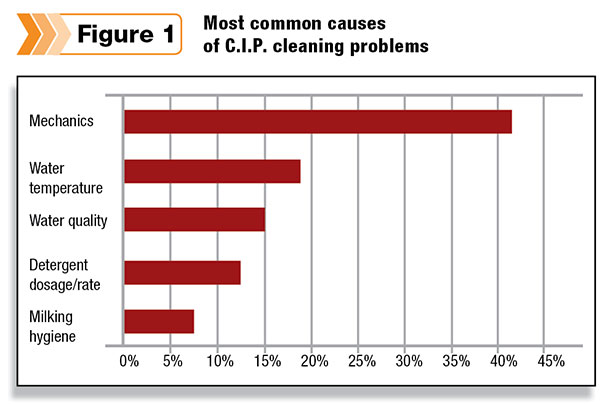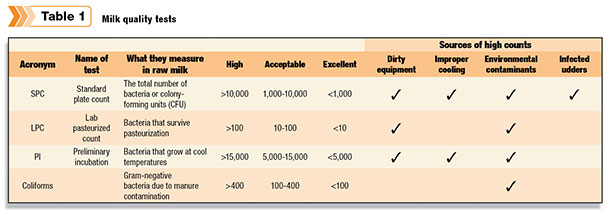When it comes to producing high-quality milk, clean milking equipment is a crucial part to achieving this goal. Monitoring milk quality counts, and keeping your milking equipment cleaning on track is a must to consistently produce high-quality milk.
All it takes is a failed drain or bad gaskets leaking air because they weren’t changed on schedule, to derail your cleaning system. And all of a sudden, your bacteria count is higher than expected.
To ensure clean milking equipment, these six requirements must be met: time, temperature, water volume, chemical balance, velocity and drainage. If one is off, your cleaning results will be compromised.
The clean-in-place wash contains up to four different cycles. Each has a specific function, and each needs precise control of the six requirements to properly clean your milking equipment.
-
Pre-wash/rinse. This cycle removes 90 to 95 percent of the soil load from the milking system and warms the equipment surface for cleaning. The water starting temperature should be 95 to 110ºF.
The water should circulate once to rinse the equipment and then be diverted out of the system. Ideally, the cycle will have enough water to rinse until it drains clear at the end.
-
Main wash. This cycle removes butterfat, protein and minerals. It uses slugs of hot water and chemicals to scrub the interior surfaces. For good results, you must:
- Have a starting water temperature of 160ºF or above
- Discharge water with a temperature of 120ºF or above
- Deliver 20 good slugs going 25 to 35 feet per second through the system
- Have the proper amount and type of chemical for your milking system size, complexity, hours of milking and water type
- Traditional wash cycles use a chlorinated alkaline detergent, and you need to meet the minimum active alkalinity parts per million (ppm), active chlorine ppm and pH for your system.
- Specially formulated one-step washes can be used to help save water and time but must meet the minimum required active acidity and pH for your system and be compatible with your water type.
On this type of wash, the acid rinse is not needed, and it combines the functions of two cycles into one.
- Circulate washwater seven to 10 minutes depending on how quickly you can generate slugs. For example, if you can generate three slugs per minute, you could achieve 20 slugs in seven minutes. But if you only generate two slugs per minute, then you need a 10-minute wash.
-
Acid rinse. This cycle is used to neutralize any detergent residue, remove minerals and inhibit bacteria growth. The acid rinse must circulate for three to five minutes. The water start temperature should be 95 to 110ºF, and the pH of the acid solution must be 2.0 to 3.5.
-
Sanitize cycle. This cycle kills bacteria. Use an EPA-registered sanitizer product. The water start temperature should be 95 to 110ºF and circulate for three to five minutes. Chlorine sanitizers should yield 100 to 200 ppm of chlorine when testing the drain of the cycle.
An alternative is to use an EPA-registered acid sanitizer on the acid cycle and do the acid and sanitize in one cycle.
How to ensure success
Every step of the wash cycle has its own requirements for time, temperature, water volume, chemical balance, velocity and drainage. Optimally cleaning your milking equipment requires more than pushing the button and walking away.
Every time someone starts the wash cycle, they should do a walk-through of your milking system and look and listen to see if it is working correctly. Check to make sure all of the liners are plugged into the jetters and not sucking air.
Look to see if water is running through all of the units and milk sensors. Listen to hear if the air injector is cycling on and off properly or if you hear air leaking somewhere. Too much air in the system can alter slug performance and cool water temperature. Make sure you hear the air injector firing and a slug entering the receiver jar right when the air injector stops.
Monitor the temperature of the wash routinely. If you have a temperature recorder, check the charts on a regular basis. If not, keep a thermometer in the milk house. Use it to check the temperature of the drain of the main wash cycle weekly.
When the temperature of the washwater leaving the system falls below 120ºF, butterfat and solids start falling out of suspension and onto your milking equipment.
Also make sure all cycles are draining quickly and completely. If the drain is too small, water temperature drops and if it gets too low, will leave a film on the bottom of the receiver.
Creating a slug
A full column of cleaning solution propelled by air injected into the line requires the right amount of water volume with just the right amount of force from air injectors to push the cleaning solution through and maintain the slug.
Too much force causes the slug to move too fast, break apart – and therefore does not adequately clean the equipment. If the slug moves too slow, or does not contain enough water volume, it doesn’t clean the whole pipeline. Slugs should be propelled at 25 to 35 feet per second.
Water volume is critical. In order to clean all inside surfaces, you need enough water to create a slug that keeps the chemicals in contact with all of those surfaces as it moves through the system.
Too much water dilutes the chemicals, which can result in ineffective cleaning or cause you to use more chemical. Not enough water and the wash vat sucks air, preventing the formation of wash slugs, causing ineffective cleaning of the milk line.
Monitor chemical usage
Each week, mark the detergent, acid and sanitizer containers. This allows you to see if the right amount is being used each week. If you are using too little chemical, it will lead to a cleaning failure and high bacteria counts.
If you are going through too much, it is costly and can cause premature failure of rubber goods. For example, if your chlorine is supposed to be set for 100 ppm but you use 300 ppm, you are using too much, raising your cost, causing gaskets and liners to deteriorate more quickly.
Biofilms form in equipment when washing failures happen and when the system is not washed at least every 10 hours when the system is milking 24-7. If the cows are milked 3X, the milking equipment must also be cleaned 3X. Shortcuts on cleaning often lead to high milk quality counts.
More than 40 percent of cleaning problems are caused by mechanical issues (Figure 1).

Improper system maintenance, failure of the air injector to create wash slugs and water temperature that is too cold are often culprits. Put someone in charge of routine maintenance.
Establish a replacement schedule for all wear goods, gaskets, diaphragms, wash vat drains, chemical peristaltic tubes and other parts that wear out over time, and record when you change them.
Always monitor your milk quality tests: standard plate count, also known as plate loop count, lab pasteurized count, preliminary incubation, coliform counts and somatic cell count. When they increase, something is causing it. Use Table 1 to determine when to take action and where to look.

Take a team approach and get help monitoring your counts from a specialist you work with.
When your bacteria count goes up, stop and evaluate the six elements of cleaning. Make sure these elements are being met with each washing. PD
Keith Engel is a dairy farm hygiene and supplies specialist with GEA. Email Keith Engel or (630) 640-3665.
PHOTO: To ensure clean milking equipment, these six requirements must be met: time, temperature, water volume, chemical balance, velocity and drainage. Photos provided by GEA Farm Technologies.

-
Keith Engel
- Dairy Farm Hygiene and Supplies Specialist
- GEA Farm Technologies
- Email Keith Engel






